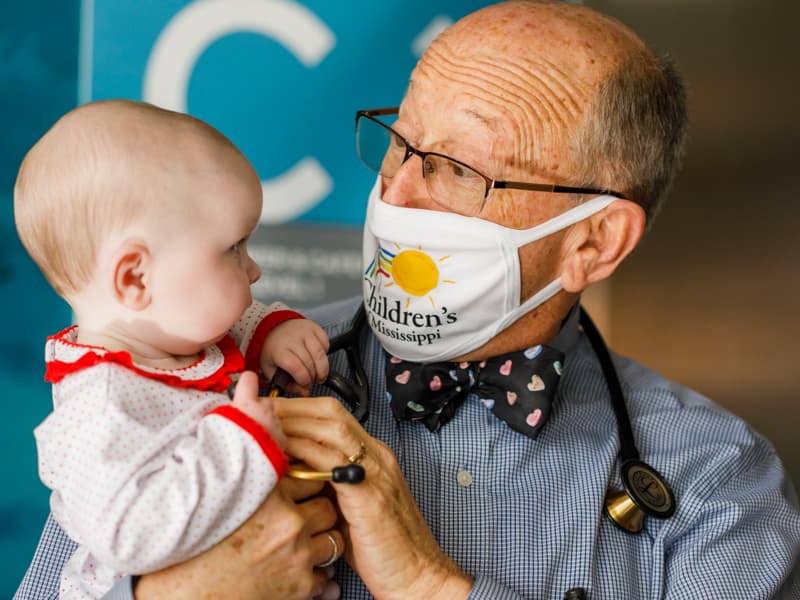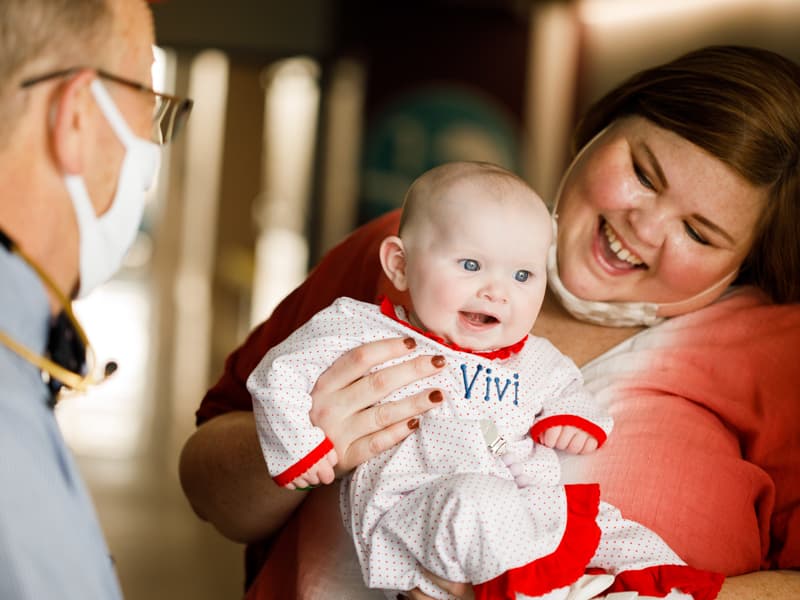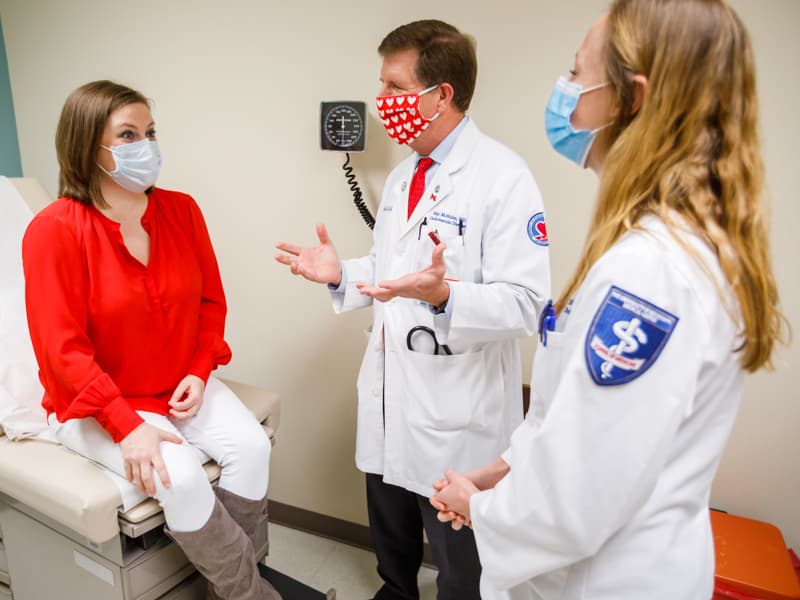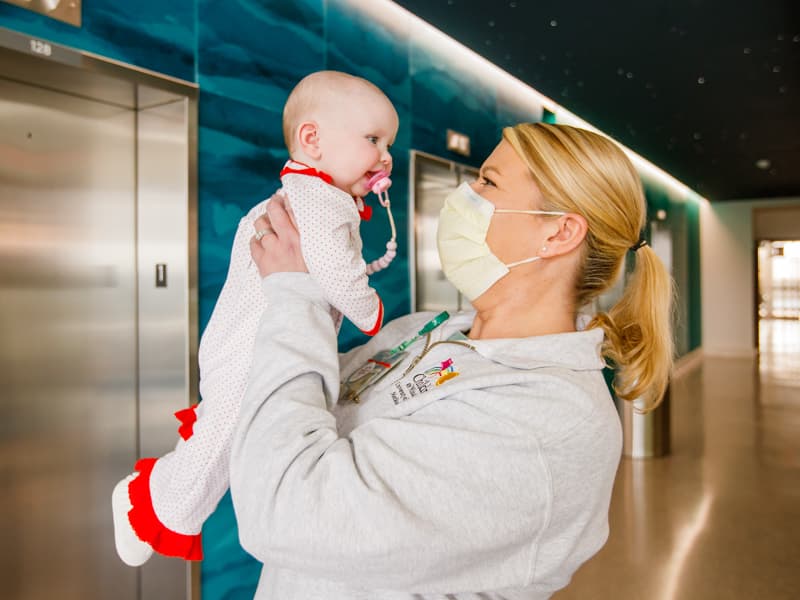UMMC's congenital heart warriors spring from all ages, sizes

Kelly Gordon, 40, and Vivian Hebert, 7 months old, may differ in age, but they are both congenital heart warriors.
Both of Brandon, Gordon and Vivian, or Vivi, were born with heart defects that were diagnosed when they were getting medical care for other reasons. Gordon’s was found during a routine check-up, while Vivi was visiting her pediatrician due to a milk allergy.
In the U.S., congenital heart disease affects an estimated one out of every 100 babies.

"Congenital heart disease is very common,” said Dr. William Moskowitz, chief of the Division of Pediatric Cardiology at the University of Mississippi Medical Center and co-director of the Children’s Heart Center. “Congenital means ‘present at birth,’ so a congenital heart defect is one that you’re born with. Congenital heart defects are the most common birth defects. Although great progress has been made in diagnosing congenital heart defects before birth and at birth, undiagnosed congenital heart defects can be found in adults.”
‘A Pink Tet’
Vivi’s heart defect came as a shock to her family.
“We had no idea,” said Vivi’s mom Crystal Hebert. “She was referred to Children’s of Mississippi and was diagnosed at three weeks old with tetralogy of Fallot.”

Considered a critical congenital heart defect, tetralogy of Fallot includes four defects: a hole in the wall between the heart’s two lower chambers (ventricles), a muscular obstruction to the blood leaving the right ventricle, a narrowing of the pulmonary valve and possibly the main pulmonary artery, and an enlarged aorta that sits over the hole, receiving blood from both ventricles.
Often babies with tetralogy of Fallot are blue from reduced oxygen in their blood, tipping doctors off that a heart defect may be present. Vivi, Crystal said, “is a pink tet.”
Pink tetralogy of Fallot has a mild obstruction of the right ventricle, so it does not cause cyanosis, or bluish skin. According to the U.S. Centers for Disease Control and Prevention, pink tetralogy of Fallot sometimes is diagnosed as late as adulthood.
Surprise diagnosis

Gordon’s congenital heart defect was diagnosed nine years ago, when she was 32. Life changed quickly over a whirlwind 10 days that saw her visiting her primary care provider because she’d noticed heart palpitations, her swift referral to a cardiologist who diagnosed her with coarctation of the aorta, and the surprise news that she was pregnant.
“I’d gone to my doctor just for a regular check-up,” Gordon said. “I’d been on blood pressure medicine for several years, but I wrote that off as hereditary. I was doing well, but I told her that I sometimes had heart palpitations.

“She did an EKG and referred me to Dr. Mike McMullan,” Gordon said of Dr. Manisha Sethi, an internal medicine specialist in Ridgeland.
McMullan, at that time in private practice but now head of the Division of Cardiovascular Diseases at UMMC, gives kudos to Sethi for quickly recognizing that Gordon needed to see a cardiologist. “The interesting thing is that she already had high blood pressure and a soft (heart) murmur, and she was only 32,” McMullan said. “You wouldn’t expect that in a healthy young woman. That immediately gets your attention.”
A significant number of congenital heart defects, such as a hole in the atrial septum or coarctation of the aorta, often aren’t discovered until adulthood if they are mild at birth, McMullan said.
McMullan suspected Gordon had the extremely rare coarctation of the aorta found in just 4 of every 10,000 newborns. He performed an EKG and echocardiogram but wanted a closer look and scheduled a CT scan.
“They asked if there was a chance that I was pregnant, and I said I was trying,” Gordon said. “They did blood work, and it was negative.”
The CT scan confirmed coarctation of the aorta, a condition in which the arteries have significantly narrowed, restricting blood flow to and from the heart. McMullan also diagnosed Gordon with having a bicuspid aortic valve, a condition in which the aortic valve has just two cusps instead of three. That can cause the heart's aortic valve to narrow, preventing the valve from opening fully and reducing or blocking blood flow from the heart to the body.
McMullan advised Gordon to hold off on becoming pregnant until her defect could be addressed by installing a stent. “It’s a good thing that you’re getting this fixed so that you won’t have to worry about it when you become pregnant,” McMullan remembered telling her.
She came back several days later for a heart catheterization, and McMullan scheduled a second CT scan to rule out an aneurysm in her head.
“The day before that appointment, I had a positive home pregnancy test,” Gordon said. “I was in there for the ride.”
Children’s of Mississippi care
Because her defect was congenital, McMullan sent Gordon to Children’s of Mississippi, where she was followed by Dr. Makram Ebeid, professor of pediatric cardiology and director of the Pediatric Catheterization Lab. “We had to watch her during pregnancy at UMMC,” McMullan said.
McMullan “said we’ve got to get all of your doctors at UMMC. That’s why I’m in the UMMC circle today,” Gordon said.
Ebeid was among those monitoring Gordon through her high-risk pregnancy and delivery, which luckily was uneventful. Maternal-fetal specialists Dr. Michelle Owens, professor and chief of the Division of Maternal Fetal Medicine, and Dr. Rachel Morris, associate professor of obstetrics and gynecology, were among those on her care team.
“Coarctation of the artery is a disease where we would want to plan a C-section delivery to reduce stress on the patient’s aorta and reduce the risk of rupture,” McMullan said.
“They said that had we not known about my defect and I’d gotten pregnant, I probably would have died in childbirth because of the pressure on your heart when you deliver,” Gordon said.
After Gordon’s son Davis was born in October 2012, Ebeid placed a stent in Gordon’s descending artery in February 2013. This opened the artery to give her the life-sustaining blood flow she needed. “I went from 4 millimeters to 14 millimeters,” she said.
Hearts of all sizes
Gordon’s son Davis also was born with a bicuspid aortic valve – something that can be hereditary, McMullan said.
Gordon sees McMullan annually to watch for thickening of her arterial wall and whether one day she’ll need a replacement stent. “Everything usually checks out well,” she said.
Davis sees Ebeid periodically, but he’s a healthy and active little boy with no restrictions. “We’re really just watching it,” Gordon said.

Vivi and her family are regular visitors at the Children’s Heart Center, which is now in the newly opened Kathy and Joe Sanderson Tower at Children’s of Mississippi.
In August, Vivi had her first surgery, a shunt procedure to allow pulmonary blood flow around the obstruction. Her next surgery, to correct the defect, will be scheduled in April. Her visits grow more frequent as her surgery date nears.
“Everyone at the Children’s Heart Center, they’re our saviors,” Hebert said. “We’re very blessed they’re taking care of Vivi.”
Hebert and husband Kyle moved to Brandon from Starkville to be closer to the state’s only children’s hospital before Vivi’s surgery and after.
“People ask me if we’re nervous about her surgery,” she said. “I’m nervous for Vivi, but not about her care. She’s in skilled hands. They care for her like they’d care for their own children here. I have faith.”
Advances made in congenital heart disease detection and treatment give those born with defects hope.
“As technology has improved and treatment of these patients has improved, we now have more adults with congenital heart defects than children,” McMullan said. “They have a higher quality of life.”
“I try not to take days for granted,” Gordon said. “Dr. McMullan is amazing. He knew just from looking at me that something was wrong.”


